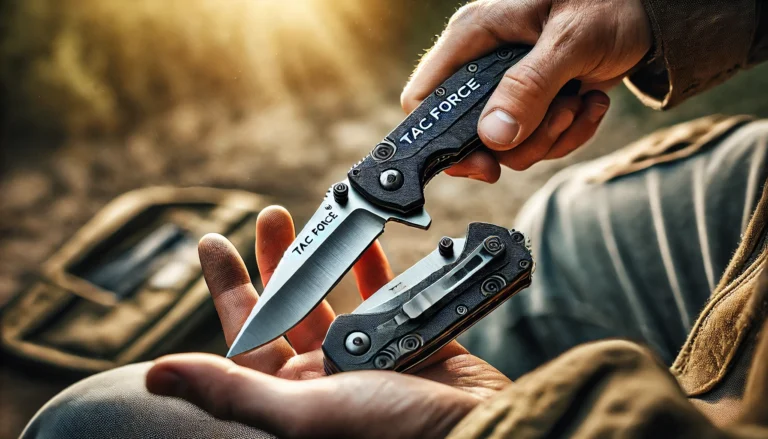
In the world of locks and keys, the deadbolt lock is a stronghold against unwanted entry. But what if you’ve locked yourself out and have no key? Don’t worry; we’ve got a solution that might surprise you. Your ordinary kitchen knife could be the hero of the day. This blog post will teach homeowners, security-conscious individuals, and DIY enthusiasts how to open a deadbolt lock with a knife safely and effectively.
How to Open A Deadbolt Lock With A Knife? (Short Answer)
First, choose a sturdy kitchen knife with a thin blade. Insert the blade into the gap between the door and the frame next to the lock. Gently wiggle the knife, pressing the blade against the bolt. Slowly apply pressure until the bolt starts to retract. Continue this motion until the lock fully disengages and the door opens.
Understanding Deadbolt Locks
Before jumping into the technique, let’s know what we’re dealing with. Deadbolt locks are widely used for their strength and security. Unlike spring bolt locks, deadbolts cannot be forcefully retracted when the door is closed. This makes them a popular choice for external doors. However, this also means they can be pretty challenging to open without the right tools—or so it seems.
Why Use a Knife?
Why a knife? Knives are everyday household items that everyone has access to. While they aren’t ideal for picking locks, they can be surprisingly effective in specific scenarios. We’ll explore how you can use a knife to manipulate the internal mechanisms of a deadbolt lock.
Safety First
Before you attempt to open a deadbolt lock with a knife, it’s crucial to prioritize safety. Knives can be dangerous if not handled correctly. Always ensure that the blade points away from you and that your fingers keep the edge clear to prevent accidental cuts. Also, remember that tampering with locks you do not own or have permission to access is illegal and unethical.
The Right Type of Knife
Not all knives are suitable for this task. A sturdy, thin, and flexible knife works best. A butter knife or a similar kitchen utensil can be ideal. Avoid using sharp or serrated blades, which can damage the lock or cause injury.
Preparing for the Task
Preparation is critical to success. Have your knife ready, and understand that patience is vital. This process may take some time, so remain calm and persistent. Ensure the area is well-lit to clearly see what you’re doing.
Inserting the Knife
Hold the knife firmly and insert it into the keyhole. You want to feel any resistance as you slide the knife in. The blade should be thin enough to fit into the keyhole without much force.
Feeling for the Pins
It would help if you felt for the pins once the knife is inside the lock. These pins are what keep the lock secure. Move the knife slowly up and down, trying to sense where the pins are. This step requires a gentle touch and a lot of patience.
Manipulating the Pins
When you locate the pins, start applying slight pressure. The goal is to push the pins to the shear line, where the lock will turn. This can be tricky and may take several attempts. Wiggle the knife and apply varying pressure to find the right touch.
Applying Torque
While manipulating the pins, you also need to apply torque to the lock. This means turning the knife as if it were the key. This torque helps to keep the pins in place once they reach the shear line. Combine this action with the previous step for the best results.
Listening for Clicks
A good indicator that you’re making progress is listening for clicks. These clicks signify that the pins are moving into place. Continue to apply gentle pressure and torque until you hear these sounds.
Practicing Patience
Opening a deadbolt lock with a knife takes a lot of work. It requires patience and persistence. If you don’t succeed on the first few tries, take a break and come back to it. Rushing can result in mistakes or even damage to the lock or knife.
Alternative Methods
If using a knife proves too tricky, there are alternative methods you can try. Tools like bobby pins or paper clips can also be used to manipulate the pins inside a lock. These objects are sometimes more effective and easier to handle than a knife.
Learning the Legalities
It’s essential to understand the legal implications of lock picking. Using these techniques on locks, you do not own or have explicit permission to access is against the law and is considered criminal activity. Always use these skills responsibly and ethically.
When to Call a Professional
Sometimes, despite your best efforts, picking a lock might be beyond your capabilities. In such cases, it’s best to call a professional locksmith. They have the tools and expertise to open locks without causing damage.
Enhancing Your Home Security
Understanding how deadbolt locks work can also help you enhance your home security. Consider upgrading to more secure locks or adding additional security measures to keep your home safe from potential intruders.
Conclusion:
Opening a deadbolt lock with a knife is possible but needs patience and caution. Always use a safe knife and handle it with care to avoid injury. Remember, only pick locks that are yours or that you have permission to access. If you’re unable to open the lock, it’s best to call a locksmith. Practice safe and legal methods for unlocking doors.
FAQs
Not all knives are suitable for this task. It’s best to use a sturdy, thin, and flexible knife, such as a butter knife. Avoid using sharp or serrated blades, which can damage the lock or cause injury.
It would help if you only attempted to open your own locks or have explicit permission to access them. Tampering with locks that don’t belong to you is illegal and unethical. Always use this skill responsibly.
The time it takes can vary depending on your experience and the lock. This process requires patience and persistence, so it might take several minutes or even longer to successfully open the lock.
If you’re having difficulty opening the lock, consider alternative methods, such as bobby pins or paper clips. If all else fails, it’s best to call a professional locksmith who can open the lock without causing damage.
Using a knife can be dangerous if not handled properly. Ensure the blade points away from you and keep your fingers clear of the edge to prevent accidental cuts. If you need more confidence, it’s better to seek help from a professional.






